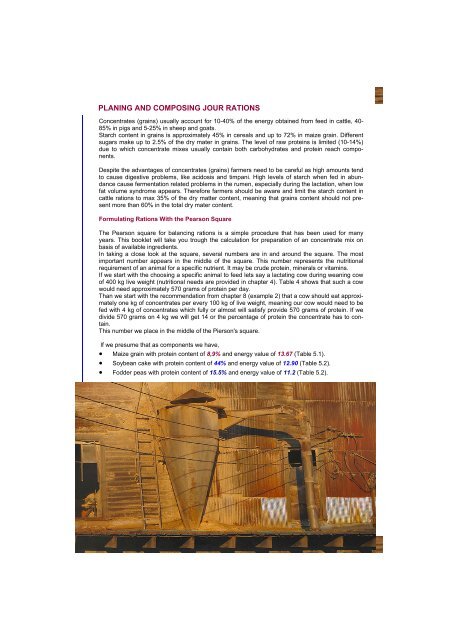HOME MADE ANIMAL FEED CONCENTRATES - usaid
HOME MADE ANIMAL FEED CONCENTRATES - usaid
HOME MADE ANIMAL FEED CONCENTRATES - usaid
Create successful ePaper yourself
Turn your PDF publications into a flip-book with our unique Google optimized e-Paper software.
PLANING AND COMPOSING JOUR RATIONS<br />
Concentrates (grains) usually account for 10-40% of the energy obtained from feed in cattle, 40-<br />
85% in pigs and 5-25% in sheep and goats.<br />
Starch content in grains is approximately 45% in cereals and up to 72% in maize grain. Different<br />
sugars make up to 2.5% of the dry mater in grains. The level of raw proteins is limited (10-14%)<br />
due to which concentrate mixes usually contain both carbohydrates and protein reach components.<br />
Despite the advantages of concentrates (grains) farmers need to be careful as high amounts tend<br />
to cause digestive problems, like acidosis and timpani. High levels of starch when fed in abundance<br />
cause fermentation related problems in the rumen, especially during the lactation, when low<br />
fat volume syndrome appears. Therefore farmers should be aware and limit the starch content in<br />
cattle rations to max 35% of the dry matter content, meaning that grains content should not present<br />
more than 60% in the total dry mater content.<br />
Formulating Rations With the Pearson Square<br />
The Pearson square for balancing rations is a simple procedure that has been used for many<br />
years. This booklet will take you trough the calculation for preparation of an concentrate mix on<br />
basis of available ingredients.<br />
In taking a close look at the square, several numbers are in and around the square. The most<br />
important number appears in the middle of the square. This number represents the nutritional<br />
requirement of an animal for a specific nutrient. It may be crude protein, minerals or vitamins.<br />
If we start with the choosing a specific animal to feed lets say a lactating cow during weaning cow<br />
of 400 kg live weight (nutritional needs are provided in chapter 4). Table 4 shows that such a cow<br />
would need approximately 570 grams of protein per day.<br />
Than we start with the recommendation from chapter 8 (example 2) that a cow should eat approximately<br />
one kg of concentrates per every 100 kg of live weight, meaning our cow would need to be<br />
fed with 4 kg of concentrates which fully or almost will satisfy provide 570 grams of protein. If we<br />
divide 570 grams on 4 kg we will get 14 or the percentage of protein the concentrate has to contain.<br />
This number we place in the middle of the Pierson's square.<br />
If we presume that as components we have,<br />
Maize grain with protein content of 8,9% and energy value of 13.67 (Table 5.1).<br />
Soybean cake with protein content of 44% and energy value of 12.90 (Table 5.2).<br />
Fodder peas with protein content of 15.5% and energy value of 11.2 (Table 5.2).<br />
8

















